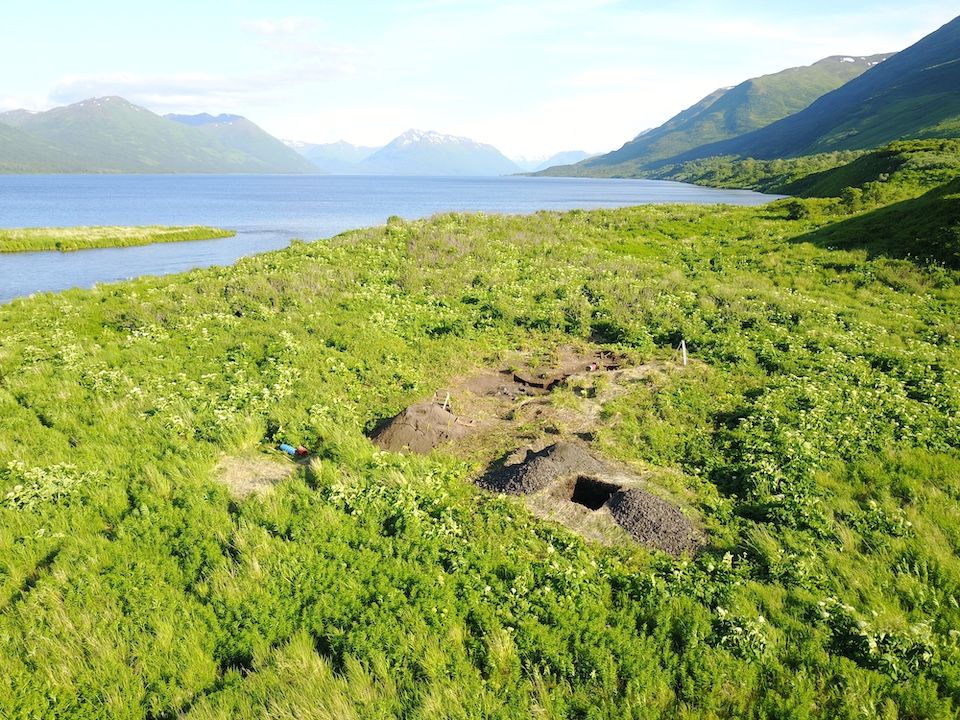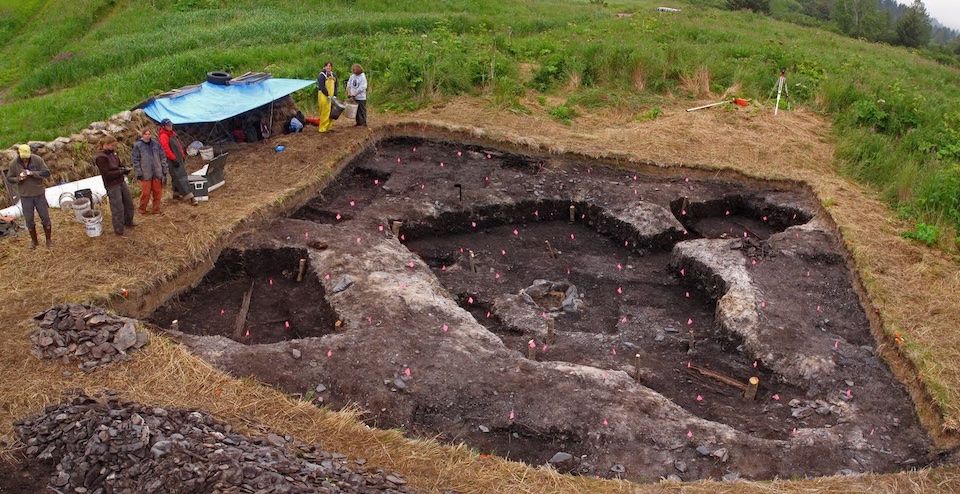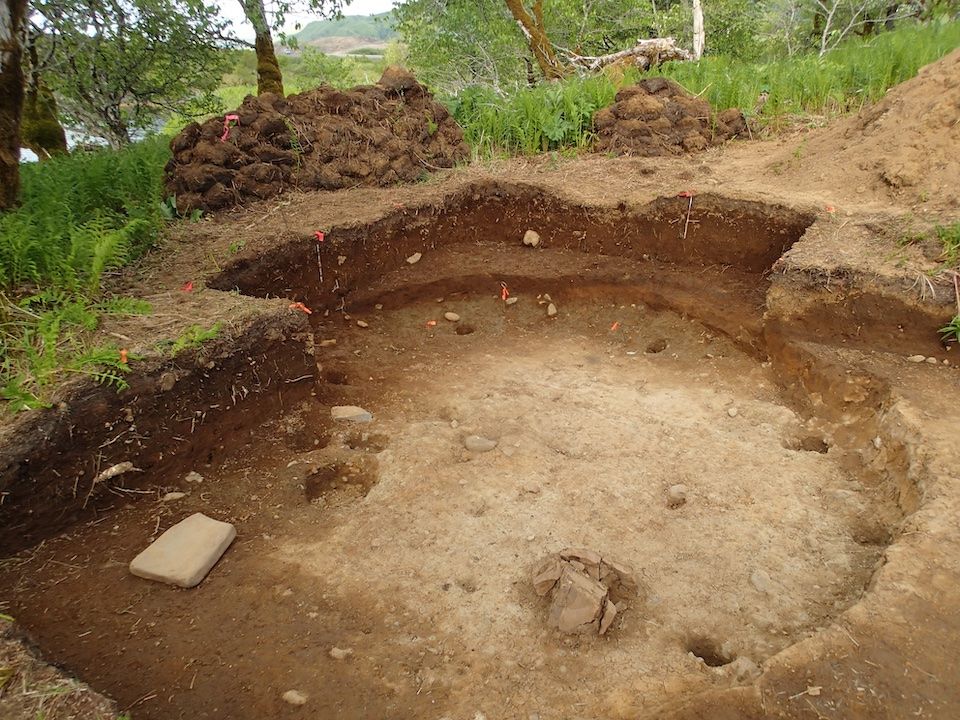Recent Studies
Buried History

Archaeological survey on the shore of northern Sitkinak Island, with Kodiak Island in the background. Supported by the National Park Service, State of Alaska, and Koniag.
Much of Alutiiq/Sugpiaq history is buried in the ground. The Kodiak Archipelago is filled with well-preserved ancestral settlements. Studies of these sites help to reveal the deep history of Kodiak’s first settlers—the Alutiiq people.

Excavations in a village site by the outlet of Karluk Lake, 2019.
Photo by Peter Olsen, courtesy Koniag.
Living at Karluk Lake
The Karluk is one of the most productive salmon systems in the Kodiak region. Alutiiq/Sugpiaq people have been using the lake and river for more than 6,000 years. To better understand Alutiiq salmon fishing and other uses of inland environments, the Alutiiq Museum and Koniag have partnered on a long-term research program. The team has studied settlements dating to 300, 1000, and 3,000 years ago.
Archaeology Presentations
- What the Fire Preserves
- Tugidak Island Studies
- Excavations in Santa Flavia Bay
- Ancient Womens Bay
- Sitkinak Island Survey
- Mikt’sqaq Angayuk
- Alutiiq Pottery
- Storytelling and Archaeology
Boston University graduate student Trevor Lamb shares his study of burned plant remains from ancestral Alutiiq/Sugpiaq archaeological sites.
Supported by Boston University, the National Science Foundation, Koniag, and the EVOS Trustee Council through the CORaL network.
Tugidak is a low-lying marshy island at the southern end of the Kodiak Archipelago. Museum archaeologists surveyed the island for settlements to learn how Alutiiq ancestors lived in this environment. Learn about their finds and how erosion is shaping the landscape.
Supported by the Tangirnaq Native Village and the US Bureau of Indian Affairs.
At the head of Santa Flavia Bay there is a cluster of archaeological sites that document thousands of years of Alutiiq settlement—from 7,300 years ago to the Russian era. Archaeologist Patrick Saltonstall explores the sites and shares finds from excavations of their contents.
Supported by the Alutiiq Tribe of Old Harbor and the US Bureau of Indian Affairs.
Alutiiq Museum archaeologists have been studying the deep history of Womens Bay, excavating sites to understand how Alutiiq ancestors lived in this one setting from distant past to the historic era. Molly Odell shares recent finds from the area’s oldest sites—settlements and camps of the Ocean Bay tradition.
Supported by Koniag.
For many years, the Alutiiq history of Sitkinak Island has been a mystery. This large mountainous landmass at the southern end of the Kodiak Archipelago has not been home to an Alutiiq community for nearly two centuries and few archaeologists have visited the remote region. Early Russian accounts suggest there were two sizeable villages on Sitkinak in the late 1700s, and reports of ancestral settlements filled with sea mammal bone hint that the island was once a whaling center. Yet there were just nine Alutiiq sites recorded across the entire 91 square mile island, an uncharacteristically low number.
Was Sitkinak little used in the past? Have settlements been lost to erosion? Or is the island’s thin record of human use a symptom of limited study? In 2021, Alutiiq Museum archaeologists set out to answer this question.
Supported by the National Park Service Tribal Heritage program.

At a small workstation overlooking Womens Bay, Alutiiq men fished for cod and trapped foxes. The year was 1830 and they were working for the Russian American Company. They lived in ciqlluat–sod houses with a living room and at least one side room for sleeping and steam bathing, but they used a variety of tools made in Europe. Archaeologists studying one of the houses found cast lead shot, parts of metal fox traps, an axe head, pots, silverware, and china in addition to traditional tools like ulus, spear points, harpoons, and adzes.
Supported by Leisnoi, Inc.
Elizabeth Groat of Utah State University is studying the ways Alutiiq ancestors made and used pottery. She shares her research in this presentation given in the fall of 2023.
Supported by the Kodiak History Museum, Alutiiq Museum, and EVOS Trustee Council through the CORaL Network.
Hollis Miller and Allison Pestrikoff Botz share how they are learning about the Alutiiq history through collaborative archaeological studies on Sitkalidak Island.
Supported by the Kodiak History Museum, Alutiiq Museum, EVOS Trustee Council through the CORaL Network, the Old Harbor Native Corporation, and the National Science Foundation.
Life by Midway Bay

What was it like to live in Old Harbor hundreds of years ago? Archaeologists studied this question by investigating ancient settlements on a small thumb of land at the entrance to Midway Bay. Over five weeks, a team of museum researchers and Old Harbor students peeled back the layers of three small sites. At each, they revealed ancient buildings and recovered objects that hint at past activities—camping, tool making, seal hunting, cod fishing, cooking, and preserving.

Puyuk Site
Some of the first visitors to Midway Bay stopped along the shore of a protected cove by a stream about 7200 years ago. Here they made stone tools and built a round structure. This building had a wood frame, a sod roof, and a gravel floor. There was a pit in its center surrounded by charcoal, fire-heated rocks, and burned soil. Archaeologists found a few artifacts inside and think that the building may have been a smokehouse. Tools found outside show that they crafted cutting implements and hunting gear. Some of the stones they used came from the Alaska mainland.

Nayurwik Site
About 6,300 years ago, an Alutiiq family camped on the shore of Sitkalidak Passage. Here, they built a small, sturdy, oval house. Partially dug into the ground, this building had a wood frame and probably wooden walls. It also had a thick, insulating cover of sod. Inside the structure residents crafted stone hunting tools, using both local materials and rock from the Alaskan mainland. Just outside the structure they ground iron oxide to make a red pigment. This pigment may have been used to preserve hides. It was found all over the house floor. Perhaps people sat on hides inside the house.

Kumluk Site
About 400 years ago, Alutiiq people built a small sod house village beside the bay. Four houses and a series of pits are the remains of a fall settlement used by several families to create food stores. Each house had a large central room and one or more side rooms. In the central rooms, archaeologists found rock and charcoal-filled pits and many post holes. Some of the pits were hearths. Others were for roasting. Still others may have been used to dry racks of hanging food. The most common tools were ulu knives for butchering, and pottery for melting blubber into oil. Researchers also found harpoons and lances for seal hunting. Animal remains show people harvested cod, salmon, shellfish, and birds.
Supported by the State of Alaska, the City of Old Harbor, and the Old Harbor Native Corporation.
